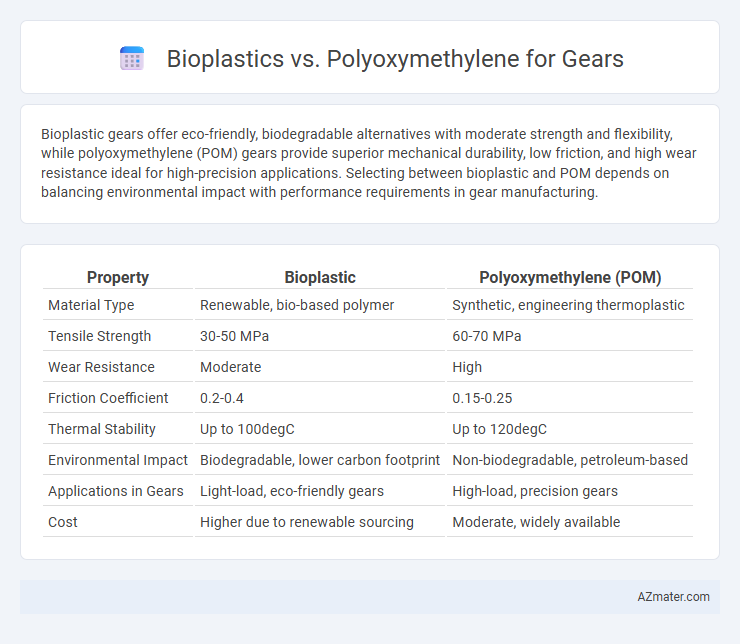Bioplastic gears offer eco-friendly, biodegradable alternatives with moderate strength and flexibility, while polyoxymethylene (POM) gears provide superior mechanical durability, low friction, and high wear resistance ideal for high-precision applications. Selecting between bioplastic and POM depends on balancing environmental impact with performance requirements in gear manufacturing.
Table of Comparison
| Property | Bioplastic | Polyoxymethylene (POM) |
|---|---|---|
| Material Type | Renewable, bio-based polymer | Synthetic, engineering thermoplastic |
| Tensile Strength | 30-50 MPa | 60-70 MPa |
| Wear Resistance | Moderate | High |
| Friction Coefficient | 0.2-0.4 | 0.15-0.25 |
| Thermal Stability | Up to 100degC | Up to 120degC |
| Environmental Impact | Biodegradable, lower carbon footprint | Non-biodegradable, petroleum-based |
| Applications in Gears | Light-load, eco-friendly gears | High-load, precision gears |
| Cost | Higher due to renewable sourcing | Moderate, widely available |
Introduction to Bioplastic and Polyoxymethylene
Bioplastics are derived from renewable biomass sources such as corn starch or sugarcane, offering biodegradable and eco-friendly alternatives to traditional plastics. Polyoxymethylene (POM), also known as acetal, is a high-performance engineering thermoplastic characterized by excellent mechanical strength, low friction, and high dimensional stability, commonly used for precision gear applications. Comparing bioplastics with POM reveals significant differences in durability, thermal resistance, and environmental impact, making material selection crucial for gear manufacturing.
Material Properties Comparison
Bioplastic offers biodegradability and reduced environmental impact with moderate tensile strength and flexibility, making it suitable for low-load gear applications. Polyoxymethylene (POM) exhibits high stiffness, excellent dimensional stability, low friction, and superior wear resistance, ideal for high-precision, durable gear systems. Comparing both, POM outperforms bioplastic in mechanical strength and longevity, while bioplastic provides eco-friendly advantages and easier recyclability.
Mechanical Strength and Durability
Bioplastic materials typically exhibit lower mechanical strength and durability compared to Polyoxymethylene (POM), which is known for its high tensile strength, stiffness, and excellent wear resistance in gear applications. POM's superior fatigue resistance and low friction coefficient make it ideal for high-load and high-speed gear operations, whereas bioplastics often require reinforcement to approach similar performance levels. The long-term dimensional stability and chemical resistance of POM further position it as the preferred choice in demanding mechanical environments over standard bioplastics.
Environmental Impact and Sustainability
Bioplastic gears offer significant environmental benefits through biodegradability and lower carbon emissions compared to polyoxymethylene (POM), which relies on fossil fuel-derived polymers. While POM provides superior mechanical strength and durability, its production and disposal contribute to persistent plastic waste and higher ecological footprints. Emphasizing renewable resources and end-of-life biodegradability, bioplastics present a more sustainable option for gear manufacturing in applications prioritizing environmental impact reduction.
Manufacturing Processes and Costs
Bioplastic gears are primarily produced using injection molding, offering cost-effective and sustainable manufacturing with lower energy consumption and biodegradable properties. Polyoxymethylene (POM) gears, manufactured through precision injection molding or machining, deliver high dimensional stability and superior mechanical strength but involve higher production costs due to material and processing complexity. Cost comparison reveals bioplastics reduce expenses in raw materials and waste management, while POM incurs greater investment in tooling and quality control to meet performance demands.
Performance in Gear Applications
Bioplastic gears offer eco-friendly advantages with moderate wear resistance and tensile strength, suitable for low to medium load applications where biodegradability and sustainability are prioritized. Polyoxymethylene (POM) gears exhibit superior mechanical performance including high stiffness, excellent dimensional stability, and low friction, making them ideal for high-load, precision gear mechanisms requiring long-term durability. The choice between bioplastic and POM depends on balancing environmental impact with the demanding performance requirements of gear applications.
Wear Resistance and Lifespan
Bioplastic gears exhibit moderate wear resistance suitable for low-load applications but generally have a shorter lifespan compared to polyoxymethylene (POM) gears. Polyoxymethylene offers superior wear resistance due to its high crystallinity and low friction coefficient, resulting in extended operational durability under high-stress conditions. The molecular structure of POM ensures minimal deformation and excellent dimensional stability, making it the preferred material for precision gears with long service life requirements.
Chemical and Thermal Stability
Bioplastics often exhibit lower chemical resistance and thermal stability compared to polyoxymethylene (POM), which offers superior performance in high-temperature and chemically aggressive environments. POM maintains dimensional stability and resists solvents, oils, and fuels, making it ideal for precision gear applications requiring durability. The semi-crystalline structure of POM provides a melting point around 175degC and exceptional mechanical strength, whereas bioplastics typically degrade or soften at lower temperatures, limiting their use in demanding gear operations.
Common Uses and Industry Acceptance
Bioplastics are commonly used for lightweight, biodegradable gears in low-load applications such as consumer electronics and packaging machinery due to their environmental benefits and increasing acceptance in green manufacturing. Polyoxymethylene (POM), renowned for its high stiffness, low friction, and superior dimensional stability, is widely adopted in automotive, industrial machinery, and precision instruments where durability and mechanical performance are critical. Industry acceptance favors POM for heavy-duty and high-precision gears, while bioplastics gain traction in sustainable product lines prioritizing eco-friendly material solutions.
Future Trends in Gear Materials
Bioplastic offers sustainable advantages with biodegradability and reduced carbon footprint, making it a promising future material for gears in eco-conscious industries. Polyoxymethylene (POM) remains favored for its high mechanical strength, low friction, and excellent dimensional stability, supporting precision gear applications. Emerging trends indicate a hybrid approach combining bioplastic composites with POM to optimize performance and environmental impact in advanced gear manufacturing.

Infographic: Bioplastic vs Polyoxymethylene for Gear
 azmater.com
azmater.com